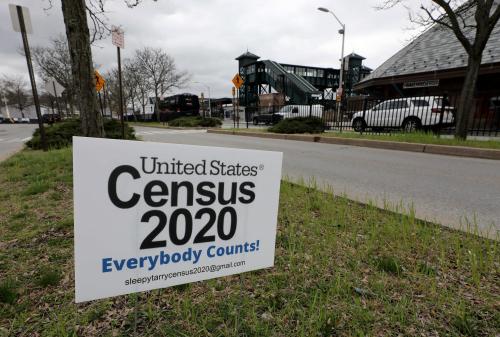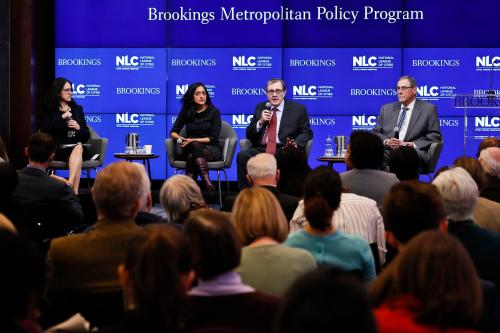The decennial Census is a genuinely powerful institution in American life. I didn’t understand its impact until I oversaw the Census Bureau as it prepared and carried out the 2000 decennial Census, when I was Under Secretary of Commerce for Economic Affairs. Believe me, the upcoming 2020 decennial Census will matter more than you think. Yet, Congress and now the Trump administration have set the 2020 decennial on a course that threatens its basic accuracy. In so doing, they put at risk the integrity and effectiveness of some of the national government’s basic missions.
Normally, the Census Bureau spends the first six years of each decade planning the next decennial Census. The Bureau’s funding ramps up in years seven, eight and nine of the decade, when it tests and purchases its technologies, conducts a nationwide inventory of residential addresses, orders forms, letters and advertising, and begins to lease local offices and train temporary workers. It is expensive to accurately locate and count 325 million people in 126 million households (2016). That’s why, for example, Census funding jumped 96 percent from 1997 to 1998, and more than 60 percent from 2007 to 2008.
The problems began in 2014, when Congress decreed that the 2020 Decennial Census should cost no more than the 2010 count without adjusting for inflation, or some $12.5 billion. The Obama administration objected, but to no effect—although it’s worth recalling that Bill Clinton took a different tack in 1998, when he vetoed an omnibus budget bill and risked a government shutdown to get rid of a provision that would have barred the Census Bureau from using statistical sampling to verify the 2000 count.
The Census Bureau did what it had to do to live within its new budget constraints: it drew up new plans to cut costs by replacing thousands of temporary Census workers and hundreds of temporary offices with new technologies and online capacities. It also had to do what it shouldn’t have done: to save money, the Bureau aborted a planned Spanish-language test census and didn’t test or implement new ways to more accurately count people in remote and rural areas. Census also ended its plans to test a range of local outreach and messaging strategies to get people to fill out their census forms, which are crucial to minimizing undercounts in many minority and marginalized communities.
Even so, the Census Bureau prepared to ramp up funding in 2017 and 2018, as it normally did, under the $12.5 billion cap. Enter the Trump administration, which cut the Obama administration’s 2017 budget request for the Census Bureau by 10 percent and then, this past April, flat-lined the funding for 2018. It is no coincidence that the Director of the Census Bureau, John Thompson, resigned in May, effective in June. It’s a serious loss, since Dr. Thompson directed the 2000 decennial count and is probably the most able person available to contain the coming damage to the 2020 count. For its part, the administration hasn’t even identified, much less nominated, his successor. It is no surprise that the Government Accountability Office recently designated the 2020 Census as one of a handful of federal programs at “High Risk” of failure.
The costs of starving the decennial Census could be great. It not only paints the country’s changing demographic and geographic portrait every 10 years. Its state-by-state counts determine how the 435 members of the House of Representatives are allocated among the states, and its counts by “Census block” (roughly a neighborhood) shape how members of state legislatures and many city councils are allocated in those jurisdictions. That’s just the beginning.
Consider as well that every year, the federal government distributes about $600 billion in funds to state and local governments for education, Medicaid and other health programs, highways, housing, law enforcement and much more. To do so, the government uses formulas with terms for each area’s level of education, income or poverty rate, racial and family composition, and more. The decennial Census provides the baseline for those distributions by counting the people with each of those characteristics in each state and Census block. Similarly, the Census Bureau conducts scores of additional surveys every year on behalf of most domestic departments of government, to help them assess the effectiveness of their programs. Here again, the decennial Census provides the baseline for measuring each program’s progress or lack of it.
Without an accurate Census, many states and cities will be denied the full funding they deserve and need, and the federal government will have to fly blind for a decade across a range of important areas.Moreover, many businesses also rely on decennial data, from retailers and commercial real estate developers to the banks that finance them. Data on the demographics and locations of potential customers not only inform their planning and investments. In some cases, the data actually make their projects possible, for example, when an investment qualifies for special tax treatment if it occurs in places with certain concentrations of low or moderate-income households.
The Trump administration’s cavalier approach to the 2020 decennial Census is evident in ways other than its funding deficit. A draft executive order, leaked but not issued so far, would direct the Census Bureau, for the first time in over 200 years, to “include questions to determine U.S. citizenship and immigration status.” The Census Bureau is legally required to protect the privacy of all Census data from requests by anyone, including government officials and it is forbidden by law to pass information about status on to the government agencies that deport people. Unsurprisingly, many people remain skeptical and avoid answering the Census out of fear that other government agencies will access their information. Requiring that Census 2020 probe each respondent’s citizenship and immigration status would turbo-charge those fears among Hispanics and other immigrant groups. The result would be systemic undercounting and underfunding of states, cities and towns with substantial populations of Hispanics and other immigrants.
There is still time for a course correction that could rescue the 2020 decennial Census, in next month’s negotiations over the 2018 budget. With some GOP members of Congress exhibiting a measure of newly-found independence from the Trump administration, Paul Ryan and Mitch McConnell could need Democratic support to pass a budget. A wide range of minority advocacy and business groups, along with most big city mayors, have vital interests in an accurate decennial Census. It’s up to them to pressure Nancy Pelosi and Chuck Schumer to make adequate funding for the Census one of their top priorities. Otherwise, one of the basic mechanisms for fair and competent governance could be disabled for a decade.
The Brookings Institution is committed to quality, independence, and impact.
We are supported by a diverse array of funders. In line with our values and policies, each Brookings publication represents the sole views of its author(s).







Commentary
The 2020 Census may be wildly inaccurate—and it matters more than you think
August 31, 2017